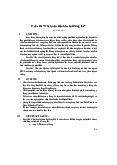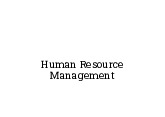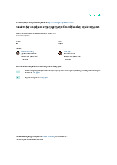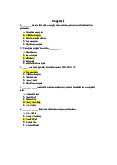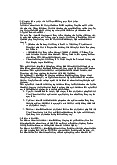





Preview text:
Documenting HR's effect on company performance
Huselid, Mark A . HRMagazine ; Alexandria Vol.39,Iss.1, (Jan 1994): 79. ProQuest document link ABSTRACT
A recent study provides some of the most comprehensive evidence available to confirm the hypothesis that the
use of progressive or sophisticated human resource (HR) management practices has a substantial and positive
impact on company performance. Human Resource Management Practice Sophistication (HRSOPH) is an index to
measure the effects of HR management on firm performance. The findings for the dependent variables of financial
performance were consistent with the results for turnover and productivity. That is, the use of sophisticated HR
management practices, net of any relevant costs, has a substantial and positive effect on corporate financial
performance. To demonstrate the financial magnitude of these effects, the impact is calculated of a one-standard-
deviation increase in HRSOPH on each of the financial performance measures, while correcting for the
simultaneity and selection biases. FULL TEXT
Despite the rhetoric and developing conventional wisdom suggesting that investment in human resources can
provide companies with a source of competitive advantage, little systematic research has been conducted on this
topic. This situation gave me the motivation to complete one of the largest studies ever conducted linking data on
HR management practices with objective measures of turnover productivity and corporate financial performance.
My study provides some of the most comprehensive evidence available to confirm the hypothesis that the use of
progressive or sophisticated HR management practices has a substantial and positive impact on company
performance. In a wide variety of companies representing diverse industries, I found that investment in such
practices led to better financial performance, higher productivity and lower turnover. I have confidence in these
results because they are consistent across several different measures of performance and have statistical
corrections for selectivity and simultaneity.
I began by addressing multiple research questions: What are the factors determining sophistication in HR
practices? What are the links between use of such practices and turnover and employee productivity? What are the
links between HR sophistication and corporate financial performance?
These questions were explored in a survey sample that included virtually all domestic corporations (excluding
holding companies) with more than 100 employees and $5 million in sales (3,452 in all). I received replies from 368
firms across 35 industries, for a response rate of 28 percent.
DEFINITION OF HR SOPHISTICATION
Since the goal of this study was to measure the effects of overall HR management practice "strategy" on firm
performance, I used a single measure or index that I called Human Resource Management Practice Sophistication PDF GENERATED BY PROQUEST.COM Page 1 of 6
or HRSOPH. The scale, developed in a Department of Labor study conducted at Columbia University. is a
compilation of HR management "best practices" in the following areas: * Personnel selection. * Performance appraisal. * Compensation. * Grievance procedures. * Information sharing.
* Attitude assessment. * Labor-management participation.
I measured policies separately for exempt and nonexempt employees, and the overall HRSOPH score is a weighted
average of each company's use of these policies for all of its employees. The HRSOPH scale has a potential range
of 0 (no sophisticated policies for any employees) to 100 (all employees are exposed to all such policies). The
mean of this scale wads 55.94. DETERMINANTS OF HRSOPH
I first wanted to know whether certain types of companies were more likely to adopt sophisticated HR
management practices or if these policies and procedures were randomly distributed across companies.
Consistent with my hypotheses, the use of sophisticated HR policies was positively related to these factors:
company size (total employment), capital intensity, business-planning sophistication, the formalization of HR
planning and the number of years someone from the HR department had been involved in the company's strategic
business-planning process. HR sophistication was negatively related to the extent of union coverage and the use
of cost leadership as a competitive strategy.
Quite simply, larger corporations and those that spend more money on capital equipment also invest in more
sophisticated HR policies. Of course, larger companies often have more money available to invest in such policies
and, in any case, these practices are often more cost-effective in terms of a lower cost per employee in larger
companies. Also, companies that engage in more sophisticated business planning see the need and the
opportunity for more HR planning. Finally, as I expected, there were large differences in HR management practices across industries.
Two prominent factors were associated with lower investments in HRSOPH. The first was the existence of a union.
Unions had a very strong negative effect on the level of HRSOPH, even after controlling for the fact that companies
in highly unionized industries exhibited lower HRSOPH (nonunion companies in highly unionized industries had
much higher HRSOPH than did the unionized ones). Second, companies that adopted a cost leadership
competitive strategy had much lower HRSOPH (and paid lower wages as well) than did those following a
differentiation or a focus competitive strategy. PRODUCTIVITY AND TURNOVER
The next step was to examine the effects of the use of sophisticated HR management practices on corporate PDF GENERATED BY PROQUEST.COM Page 2 of 6
financial performance. However, HR management practices do not directly influence corporate performance, but
rather do so indirectly by influencing the quality and behavior of employees. The links between employee
performance and financial performance can be unpredictable, since a wide variety of factors outside the control of
individual employees--such as general economic conditions and competitors' responses--can affect the company's
performance. Thus, I began by examining effects of HRSOPH on turnover and productivity.
To summarize a lengthy set of analyses, the use of sophisticated HR management practices had a substantial
negative impact on turnover, even after statistically controlling for an extensive list of company and industry-
specific factors. Stated another way, higher HRSOPH was associated with lower turnover. Yet, these findings do
not necessarily imply that increasing HRSOPH will lead to higher performance. That is, we know turnover is a
function of wages, benefits, and working conditions, and companies with relatively higher turnover often pay
substantially lower wages. We could be much more confident in the utility of increasing investments in HRSOPH if
such investments could be shown to be related to employee productivity, and ultimately, corporate financial performance.
Thus, in a more rigorous test of the benefits associated with the use of sophisticated HR management practices, I
found HRSOPH to have a significant positive impact on productivity (sales per employee), even after controlling for
all relevant company and industry-specific factors. To demonstrate the practical magnitude of these findings, I
calculated the impact that increasing HRSOPH by one standard deviation (a measure of spread or variability
around a variable's average) would have on employee productivity. My calculations showed that each standard
deviation increase in HRSOPH increases net sales an average of $8,337 per employee per year.
However, investments in HR can usually be expected to provide gains beyond the current year. If we assume
(arbitrarily) that an investment in sophisticated HR management practices this year provides benefits over the next
five years (at an 8 percent discount rate), this translates into a present-value increase in sales of $33,287 per
employee for each standard deviation increase in HRSOPH.
The effects of increased investments in HRSOPH on turnover and productivity were substantial, but sales per
employee may not be the most desirable measure of the payoffs from investments in HR management policies
and practices. That is, HRSOPH may well increase sales, but it may also increase profitability for the same level of
sales. Moreover, a potential problem with using either turnover or sales per employee as dependent variables is
that they do not incorporate the costs of implementing more sophisticated HR management practices. Thus, even
though increasing HRSOPH may lower turnover or increase productivity, these gains may be offset by the costs
associated with adopting these new practices. Estimating the net benefits associated with investments in
HRSOPH requires the use of capital market and accounting measures of company performance. EFFECTS ON THE BOTTOM LINE
Given the substantial effects of HRSOPH on turnover and productivity, the final step was to evaluate the effects of
HRSOPH on corporate financial performance. Scholars in financial economics generally believe that there are two
distinct aspects of corporate financial performance: accounting profits and economic profits. Economic profits are
measured with capital (stock) market returns, while accounting profits are presented in balance sheets and
income statements. Accounting profits can differ from economic profits because of timing issues, adjustments for
depreciation, choice of accounting method, and measurement error. Because both types of performance measures
are relevant, I used two measures of economic profits (Tobin's q and total shareholder return) and two measures of
accounting profits (gross rate of return on capital and price-cost margin). A primary advantage of these dependent
variables is that they will give us estimates of the impact of HRSOPH that are the net of any costs of implementing PDF GENERATED BY PROQUEST.COM Page 3 of 6 such practices.
Before I move on to the findings, there are two potential sources of bias in estimating the effects of HRSOPH on
corporate performance that should be described. The first is called simultaneity bias. If we find a relationship
between the use of HRSOPH and corporate performance, it may not be altogether clear whether HRSOPH caused
the higher performance or if higher performing companies simply chose to invest in more sophisticated HR
management practices. Because I measured both HRSOPH and corporate performance, simultaneously, I used an
economietric procedure (two-stage least squares regression) to correct for this type of bias.
The second potential source of bias is called selection bias. Selection bias can occur if the companies that
respond to my survey are somehow different from those that did not. For example, companies with relatively
higher HRSOPH or higher performance may be more likely to respond to questionnaires about HR policies.
Fortunately, since I obtained financial performance data for both the responding and the nonresponding firms, I
was also able to correct statistically for selection bias. PRACTICAL IMPLICATIONS
The findings for the dependent variables of financial performance were consistent with the results for turnover and
productivity. That is, the use of sophisticated HR management practices, net of any relevant costs, has a
substantial and positive effect on corporate financial performance. To demonstrate the financial magnitude of
these effects, I calculated the impact of a one-standard-deviation increase in HRSOPH on each of the financial
performance measures, while correcting for the simultaneity and selection biases mentioned above.
The results were striking. When the estimates were made of profits (measured by the market value of the firm), the
per employee effects of increasing HRSOPH by one standard deviation averaged $33,250. These increases in
market value are not likely to occur immediately, however. A likely scenario is that investments in HRSOPH create
an asset that provides an annual return. If one assumes (arbitrarily) that these returns accrue over a five-year
period, then increasing HRSOPH would provide an annuity of $8,328 per employee per year (using an 8 percent discount rate).
The results for the accounting profits were very similar. The overall average of all the annual profitability measures
across all specifications and estimation procedures was $7,868, which is remarkably close to the five year annuity
values calculated above ($8,328) for the market value measures.
In short, four different measures of corporate financial performance converged on very similar results. On a
present-value basis, increasing HRSOPH by one standard deviation produced an increase in the market value of
the firm of $33,250 per employee. Alternatively, the average expected annual increase in profits was $7,868 per
employee. The magnitude of these results is remarkable, considering that the dollar values are net of any
additional costs that increasing HRSOPH might generate. THE NEXT STEP
The question begging for response in this line of research is which individual HR policies provide the greatest
economic return? Unfortunately, this question is much more difficult to answer than asking . whether the sum of
all the HR management practices used by a company affects its performance. To provide precise estimates of the
relative efficacy of individual HR management practices, information on HR management practices and company
performance over time will be required. Therefore, the next step now underway in my research program is to PDF GENERATED BY PROQUEST.COM Page 4 of 6
replicate this study, so that changes in HRSOPH in previous years can be related to future changes in corporate
financial performance. I have recently received funding for such a project from the SHRM Foundation. This study
should yield exciting and important new data on the long-term effects of HR management practices on corporate financial performance.
AUTHOR'S NOTE. This study was partially funded by grants from the Human Resource Planning Society, the SHRM
Foundation, the Mark Diamond Research Fund and the School of Management at the State University of New York,
Buffalo. The interpretations, conclusions and recommendations, however, are mine and do not necessarily
represent the positions of these agencies.
Mark A. Huselid, Ph.D., is an assistant professor, Department of Human Resource Management in the Institute for
Management and Labor Relations at Rutgers University, New Brunswick, N.J. He was a 1993 winner of SHRM'S
Yoder-Heneman Award for his study, "The Effects of HR Policies and Practices on Turnover, Productivity, and Firm
Financial Performance," which was reviewed in the August issue of HRMagazine. DETAILS Subject:
Impacts; Personnel selection; Corporate finance; Competitive advantage; Costs;
Corporate profits; Financial management; Human resource management;
Employees; Productivity; Wages &salaries; Accounting Business indexing term:
Subject: Personnel selection Corporate finance Competitive advantage Costs
Corporate profits Financial management Human resource management Employees
Productivity Wages &salaries Accounting Location: United States--US Classification:
9190: US; 6100: Human resource planning; 3100: Capital &debt management Publication title: HRMagazine; Alexandria Volume: 39 Issue: 1 Pages: 79 Number of pages: 5 Publication year: 1994 Publication date: Jan 1994 Publisher:
Society for Human Resource Management Place of publication: Alexandria Country of publication: United States, Alexandria PDF GENERATED BY PROQUEST.COM Page 5 of 6 Publication subject:
Business And Economics--Management ISSN: 10473149 Source type: Trade Journals Language of publication: English Document type: PERIODICAL Accession number: 00819511, 00449010 ProQuest document ID: 205014478 Document URL:
http://ezproxy.uws.edu.au/login?url=https://www.proquest.com/docview/20501447 8?accountid=36155 Copyright:
Copyright Society for Human Resource Management Jan 1994 Last updated: 2020-11-18 Database:
Entrepreneurship Database,ProQuest Central LINKS Check for full text
Database copyright 2020 ProQuest LLC. All rights reserved. Terms and Conditions Contact ProQuest PDF GENERATED BY PROQUEST.COM Page 6 of 6
